Against the waves
As an industry grapples with changing tides,
a Massachusetts lobsterman wonders how long he can hold on.
Written and photographed by Matthew Eadie
Dec. 14, 2023
Steve Holler, 61, has fished for lobsters in the waters off the coast of Boston for nearly five decades. Now, facing changes in regulations and rising costs, he wonders how much longer he can continue.
Note: Matthew Eadie was awarded the 2024 Jerome A. Nachman Writing Award from Boston University's College of Communication for this story. The Nachman Award is given yearly to students who exhibit the highest quality of writing at Boston University's College of Communication.
BOSTON HARBOR, Mass.
Steve Holler begins his day long before the sun rises. He wakes up at 3 a.m., leaves his house by 3:30 a.m. and heads to a red pickup truck that awaits a 60-or-so-mile drive from Mattapoisett, a small town on Buzzards Bay, to South Boston. There sits his boat, November Gale — a 42-foot-long lobster boat he bought off his father, Fred, 20 years ago. The name is a nod to a powerful storm called a “Witch of November” that rips across the Great Lakes from time to time in the late Fall. He grabs a breakfast sandwich from a shop down the street, the only place open so early in the morning, turns on his boat, and waits for the other member of his crew to arrive. It’s 5:10 a.m.
His help is 49-year-old Frank Lenardis, who has fished with Holler for the past 20 years. Lenardis joins Holler on most weekends for some extra cash. He works full time in maintenance at Rockland Public Schools during the week, a “real job,” Holler calls it.
By 5:42 a.m. the two men head to pick up the bait for the day, which consists of six tubs of salmon heads and skeletons, the scraps leftover after the salmon is filleted for grocery stores. Most lobstermen use different bait than Holler, but it works well for him and it’s cheaper than most, just $40 a tub. Keeping costs low is imperative.
The ride out to sea takes about 40 minutes, and as the first rays of sunlight slowly pierce the seemingly endless sea, Holler lets out an impassioned sigh.
“Ahhhh, it’s gonna be a beautiful sunrise,” he says, with his stereotypical Massachusetts accent, looking ahead into the darkness of water that lies ahead.
As soon as day breaks, his sunglasses go on. Behind them is a face with wrinkles that surround his eyes like a spiderweb. He’s 61 years old. He wears a green baseball cap with a small lobster on the front. His hands have callouses and wrinkles like rolling hills and valleys. He has thick skin, both figuratively and literally, that remains tan all year long. He wears long orange fisherman pants and a hoodie underneath, with white waterproof boots. The boots are important because the deck can get slippery. He’s fallen off the back of his boat before, not something he wants to do again.
Lenardis is mostly bald with a salt-and-pepper beard. He has bright blue eyes and soft smile, with distinct wrinkles on his forehead, and usually has a cigarette dangling from his mouth. He sometimes goes shirtless on the boat, even in the dead of winter, but said that those days are starting to wither away. They aren’t as “invincible” anymore.
Both men feel their age. Holler regularly sees a doctor for a host of ailments. His knees, hips, shoulders and arms. They both pop a few pills of Tylenol to ease the pain that edges on throughout the morning.
It is an unseasonably warm October day. Halloween is just a few days away and the high is set to be over 80 degrees. As the ride out to sea continues, Lenardis comments on the weather.
“Not a bad day for the end of October,” he says.
“Yeah, weather-wise,” Holler scoffs sarcastically.
“Definitely not lobster-wise,” Lenardis responds.
It has been hard to catch lobsters this year, Holler said. One of the worst years to date. He’s been doing it for 47 years, but for the first time ever he said he’s not sure how much longer he can hold on. Costs to repair his 36-year-old boat continue to stack up, and he’s simply not making as much as he used to. The lobsters just do not seem to be as abundant this year.
“I don’t know what the hell happened,” he said. “This is the first year I’ve thought about selling this [boat], thinking one: what can I get for it? And two, what else am I gonna do?”
At 6:44 a.m., the boat stops. The first line of 25 lobster traps sits about 45 feet below the boat on the sea floor. A green and blue spray-painted buoy notifies Holler of the location of the traps. So too does an old beat-up notebook with the exact coordinates written down. Holler and Lenardis grab their thick blue gloves, hook the buoy to the motorized pulley system attached to the side of the boat, and start reeling in the traps. This is the first set they’ll pull today. They’ll do 10 more over the next eight hours, totaling 250 traps on the day.
The first one has just three lobsters. The second and third are empty. The jokes the two men made minutes earlier fade away. The day has just begun.
Steve Holler works about seven months out of the year and must make a years-worth of money in that time to survive the winter.
It was 1976 and a 14-year-old Steve Holler stood on the corner of a store in his hometown of Quincy, Massachusetts, some eight or so miles South of Boston. He grew up on the peninsula of Hough Neck, where just about “everyone knows everyone.” But that early summer day would change the course of Holler’s life. His uncle, Charles “Chuck” Holler, rounded the corner with his new wife. Chuck was a Navy SEAL, a former member of SEAL Team 1, and served in the Vietnam War. Nobody messed with Chuck.
Chuck grabbed Holler by the shirt collar and told him he was not going to let him “waste [his] life standing on the corner,” Holler recounted. He demanded that the next morning, Holler be on a lobster boat. Chuck was going to teach him how to fish.
The next morning, Holler obeyed his uncle’s command. He woke up early and stood on the dock in front of his uncle’s lobster boat. For the next few years, Chuck taught him everything he needed to know about lobster fishing: don’t stand on the rope when the traps are being dropped back in or you’ll get caught and pulled in with them. How to clean the boat after a day of fishing — a clean boat is very important. Where to drop the traps back in the water and how to find the right grooves of the sea floor that the lobsters might lay in. To always haul traps into the tide, and fish with the sun hitting you when it’s cold out. Invaluable life lessons that have proved quite valuable over the decades.
Holler fished with his uncle for many years, until he decided to start his own business with his father, Fred. He and his father clashed often over their time together, Holler said, and never had the best relationship. Twenty years ago, Holler decided to leave his father and fish on his own, something that didn’t sit too well with Fred, who died in November 2020 at the age of 80. Holler said he always loved his father, despite their differences. “He’s my father, of course I loved him,” he said.
Married and divorced twice, Holler’s life has kept him in Massachusetts, although he’s often thought of moving somewhere new — maybe Florida? Maryland? It certainly would be cheaper, but the thought never became more than just that.
He has two daughters, Courtney and Shelagh, and lives with his ex-partner, now roommate, Debbie. His stepson, Brendan, died 10 years ago at 28 years old, the result of opioids.
His uncle Chuck died in October 2022 at 72, leaving Holler as the executor of his will, something that has resulted in costly year for him, paying off debts and mortgages, and leaving all of his remaining family, other than his children, distant from him, seemingly holding a grudge that the will was left in his hands, Holler said.
As a former Navy SEAL, Chuck always carried a gold Navy “challenge coin,” a tradition that many retired armed service members do. Since Chuck’s death, Holler carries the coin in his left pocket at all times, as a way to honor his late uncle. A flag with his uncle’s name also flies atop November Gale.
“He always treated me right,” Holler said.

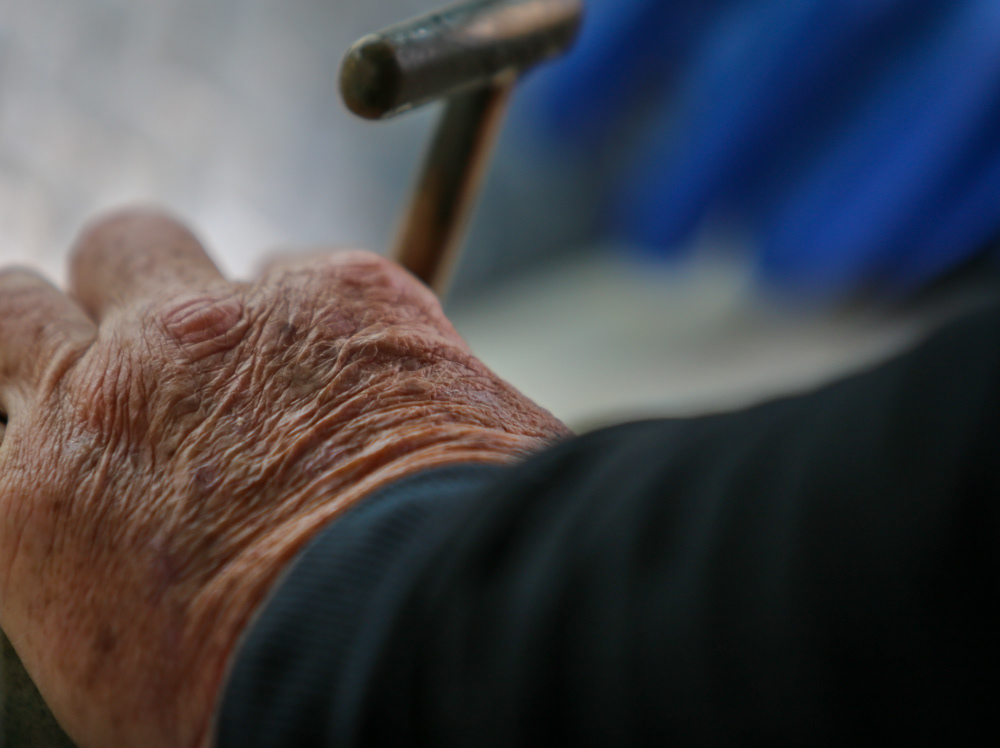
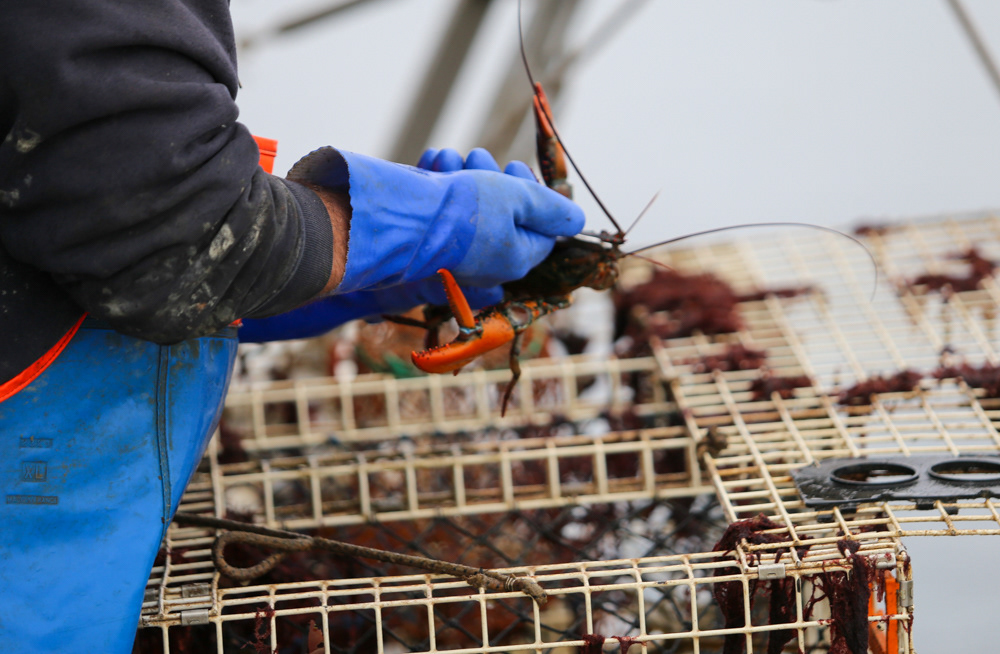
“Fuck,” Holler mutters under his breath, just loud enough to hear over the idle of the engine.
The temperature continues to rise and the lobsters just don’t seem to be in the traps. The second set of traps seems to be bent — seals were getting into them, Holler figures.
Holler and Lenardis continued to pull the traps, one by one, again and again, a tedious yet delicate process that years of experience and teamwork have made it “like a ballet.”
The trap comes up from the water, and Holler yanks it with his right arm onto the side of the boat, while controlling the rope and pulley system with his left hand, using a small lever. The two men simultaneously unstrap the bungee cords holding the trap closed at three points. Holler clears out the seaweed and scraps from the left side of the trap while Lenardis grabs the lobster (if there are any) from the right side, checking first for eggs on the underside of the lobster, and then for a “v-notch” cut into its tail.
Breeding female lobsters are illegal to keep. If a fisherman does catch one and notices it has eggs, they are required to cut a v-shaped notch into the back of its tail. Many of these breeders already have a “v-notch” from previously being caught, but if they don’t, Lenardis will cut one into the tail to notify future lobstermen that the lobster breeds. Failure to do this could result in a serious fine for Holler, but he trusts that Lenardis always checks.
If a lobster doesn’t have a “v-notch,” Lenardis checks its size with a device called a lobster gauge. Three-and-a-quarter inches, from the eye socket to the start of the tail, is the smallest size a lobster can legally be kept at. If the lobster is too small, Lenardis throws it back. If it is legal, he places it in a tray that sits behind him. After clearing out the rest of the trap from rocks, seaweed, fish, crabs and any other debris, Lenardis runs the trap down to the back of the boat and stacks it on the others in an orderly fashion. The traps will be dropped back in one by one after all 25 traps have been pulled.
As Lenardis runs the trap down to the back, Holler begins pulling the next trap from the water. They do this dance 25 times for each set of traps. A typical day consists of around 200 to 300 total traps being pulled. Lenardis makes $1 for every trap he helps Holler pull.
After all 25 traps are pulled and stacked on the back of the boat, Lenardis begins placing yellow bands around each lobster claw, counting up the total number of lobsters for Holler to keep track in his notebook. Holler then drives the boat, scanning the water for the next place to drop the traps.
“I don’t know,” he says softly and with disappointment. “I just don’t know.”
Finding where to drop the traps is a skill that takes years to master. Drop them in a straight line on gravel? Or place them in the mud around a mound on the sea floor? Leave them in the same place you had them before? Or try somewhere new? Holler says no calculation or computer analysis from scientists can calculate accurately where the lobsters are.
“You wouldn’t tell a farmer how to farm,” he said. “It’s the same thing with fishing.”
He finally decides to drop them along the side of an underwater mound on a bed of gravel. Hopefully, a few weeks from now, when he comes back to this spot, the traps will yield much more than they did today. He drops in the first trap attached to the rope and buoy, and the rest follow, one by one about 20 feet apart from one another. After all 25 traps are back in, he sets off to the next set of traps a few hundred yards away.
The difficult task of pulling 60-pound lobster traps from the water takes its toll. Lenardis makes only $1 for every lobster trap he helps Holler pull, often several hundred traps per day.
Lunchtime comes just before 10 a.m. and consists of sour cream and onion Ruffles, half a sub sandwich and a Mountain Dew. The boat doesn’t have a bathroom, so both men relieve themselves off the back of the boat before getting back to work.
They have nicknames for different numbers of lobsters they catch in each haul, something they have developed over the years. They don’t say the number “thirteen” on the boat, it’s bad luck, Lenardis said. Instead, “one more than twelve,” or “that number,” suffices. If they catch 19 lobsters in a haul, Lenardis will call out “COVID.” Holler knows exactly what that means. And if they catch 50, they say “wallace.” They haven’t caught a “wallace” in a while.
The day ends around 2 p.m., with 164 lobsters, equalling about 190 pounds. Holler unloads the lobsters to a buyer who waits in his truck at the dock, and gets paid $6 per pound. The price changes regularly, but typically range from $6 to $10, depending on the time of year and what the buyers want to offer. “That’s the end to this misery,” Holler said, referencing the low yield of the day.
A catch of 190 pounds of lobster over nearly 10 hours leaves Holler with a check for just over $1,000. He’ll pay Lenardis $250 for his help. His bait costs him around $250 as well, and fuel is another $100 or so. His earnings for the day end up being $490.
“We used to be heroes,” Holler said, waiting to unload the lobsters at the dock. “It’s gonna feel good to get the gear out of the water this year.”
Lenardis puffed away his final cigarette of the day as a plane flew overhead. “Let’s go to Key West,” Holler said sarcastically. Lenardis brought two packs of cigarettes for the morning, and smoked no less than 14 cigarettes.
Just a few years ago, Holler said he would catch 300-500 pounds a day, and drive home with a few thousand dollars in his pocket. Boat repairs each off season can costs tens of thousands of dollars, and regular payments on mortgages, car, credit cards, taxes and materials for fishing are increasingly costly. Holler is only able to fish about six to seven months out of the year, and usually just four days a week. Five hundred dollars a day under those circumstances is not enough to survive.
“We used to be heroes,” Holler said, waiting to unload the lobsters at the dock. “It’s gonna feel good to get the gear out of the water this year.”
Holler's lobster boat, named "November Gale", dedicated to his late uncle, Chuck, a former Navy Seal who taught him everything he knows about fishing. He bought the boat off late his father, Fred, about 20 years ago.
Data from the Atlantic States Marine Fisheries Commission shows that American lobster stocks in the Gulf of Maine, the water that runs along the coast of Maine, New Hampshire and Massachusetts including the Massachusetts Bay, have been increasing since 2002, and “at an accelerated pace since 2008.” Its website also says that the lobster stock is not depleted and overfishing is not occurring.
In June, ASMFC director Dan McKiernan announced that the commission approved a new Gulf of Maine conservation plan, which would implement a gradual increase in the minimum size of lobsters legally allowed to be caught in lobster management area one (where Holler fishes) from 3 ¼ inches to 3 ⅜ inches, “if and when” an abundance index of lobsters in the Gulf of Maine reached a 35 percent decline. According to McKiernan, in June the decline was 28 percent since an all-time high in 2016.
Stock assessments from 2022 were completed in the early Fall and the 35 percent threshold was surpassed. The ASMFC notified states of the implementation of the policy change in October that the three-year gradual change of the gauge sizes would begin in January 2025.
Although the increase may seem small, the change could prove costly for lobster fishermen already catching lobsters that are often too small to begin with, and many more that are just barely large enough to keep.
“The abundance of American lobster off Massachusetts, New Hampshire, and Maine is still very high and the industry’s annual catches are twice what they were two decades ago,” McKiernan wrote. “But there are signs that declines from the record highs are inevitable.”
McKiernan did note, however, that the cause of the decline in lobsters appears to be related to ocean warming and shifts in ocean currents, not necessarily overfishing.
Holler says the change in gauge size, although gradual, may have serious effects on the profitability of the already struggling lobster fisheries in Massachusetts.
“They’re punishing us but we aren’t the problem,” Holler said. “We aren’t the reason there are no lobsters.”
Jared Silva is a senior policy analyst at the Massachusetts Division of Marine Fisheries, the state government agency tasked with implementing and upholding ASMFC policies as directed by the federal government.
“The persistent poor settlement over the past decade throughout the Gulf of Maine region strongly foreshadows a downturn in stock abundance and landings,” Silva wrote in an email.
Silva said that the action by the ASMFC should increase reproductive capacity of the lobster stock in the future, and along with decreasing the maximum size lobsters allowed to be caught, allow for long-term sustainability of the Gulf of Maine lobster stock.
Holler made clear he is not opposed to regulatory measures to protect the stock. After all, he needs abundance of lobsters to survive. But emphasized that he feels the regulatory measures are not being adequately established based off the true nature of the lobster stock that he fishes nearly every day.
Every so often, Holler and other lobster fishermen welcome scientists on their boats to assess the lobster stocks, but Holler said the scientists often do not seem to take advice on where best to drop the traps in efforts to find the true abundance of lobsters on the sea floor. He said he thinks scientists should work more closely with the lobster fisherman to determine where the lobsters are.
“They tell me, ‘But you’re biased, you’re a lobsterman, you know where the lobsters are,’” he recalled someone telling him. “And I told them, ‘You’re right, and you’re the scientist, you don’t know where the lobsters are.’”
Holler said he is more than willing to work with the scientists and regulatory agencies to determine how best to regulate the waters, as long as a line is not crossed.
“I’ve been doing this since I was 14,” Holler said. “I wouldn’t tell you how to do your job, don’t tell me how to do mine.”
The ASMFC is scheduled to complete a benchmark stock assessment in 2025 that may determine future regulatory measures.

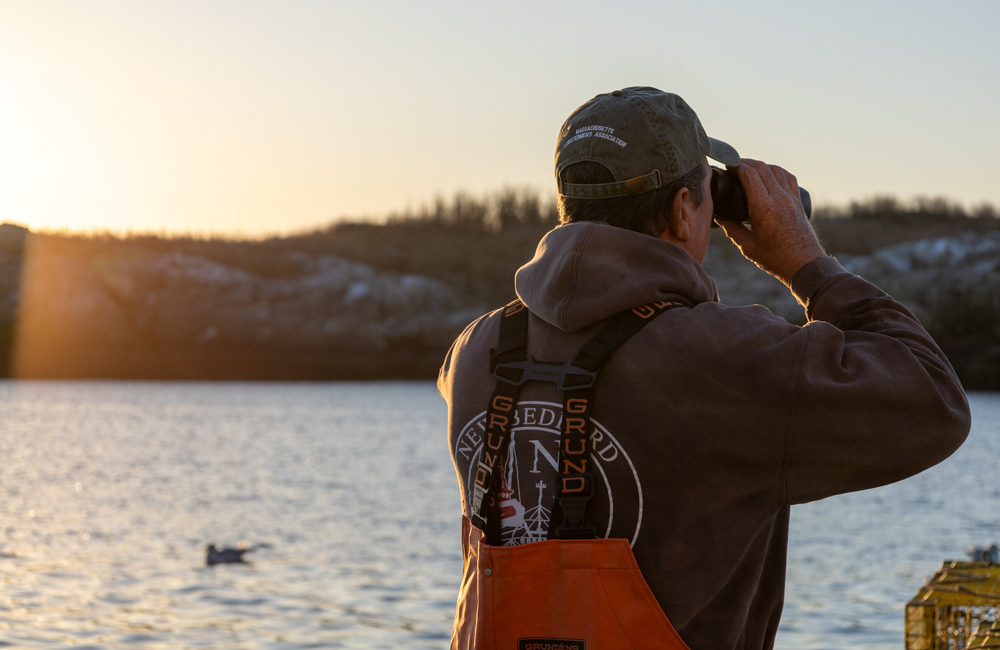
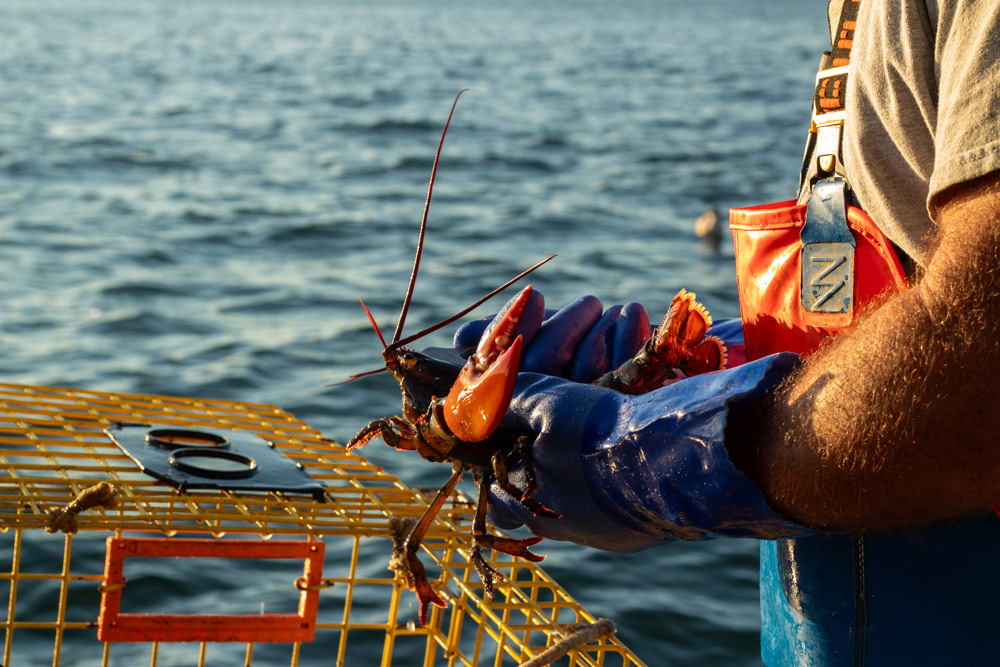
The stagnant yield of not-so-many lobsters did not seem to improve throughout the weeks after Halloween, and by mid-November, Holler was ready to call it a year. A few more trips out and maybe he could rack up enough extra cash to ensure he made it through the winter safe and sound.
For most lobstermen, the season begins to wind down as late November turns to December. The lobstermen head out one last time, stacking up 80 to 100 traps at a time on the boats, bringing them in for the winter. They are allowed to have 800 traps total in the water, so bringing them in is a time-consuming and arduous task. Technically, all traps must be in by Feb. 1 to comply with regulations protecting the passage of North Atlantic Right Whales through the Gulf of Maine and Cape Cod Bay, but unpredictable winter weather leads most to pack up shop before Christmas.
“My financial situation right now is catastrophic, to say the least.” - Steve Holler
Two weeks before Thanksgiving, Holler fell sick. The illness kept him out for two frustrating weeks, and just as he was prepared to get back in the water, his boat had other ideas.
“My boat is broken down,” read a text message from Holler on an early Sunday morning in late November. The 36-year-old November Gale needed repairs, and at a rather inconvenient time of the year.
About $900, new fuel lines, a new detonating line and one week later, the boat was ready to head back out to sea. Thanksgiving had just passed and Holler was ready too.

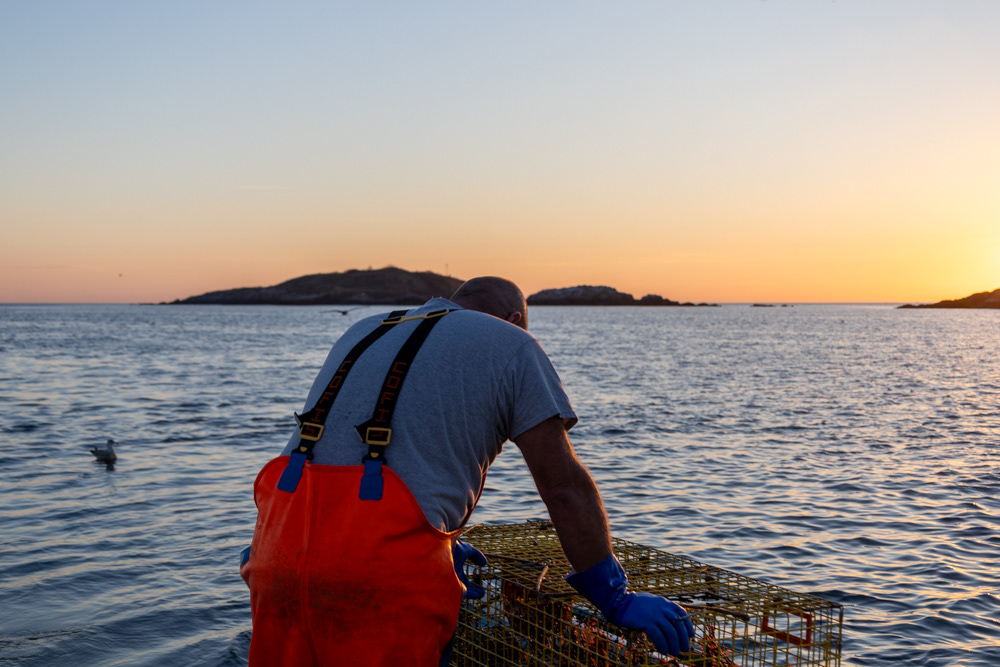
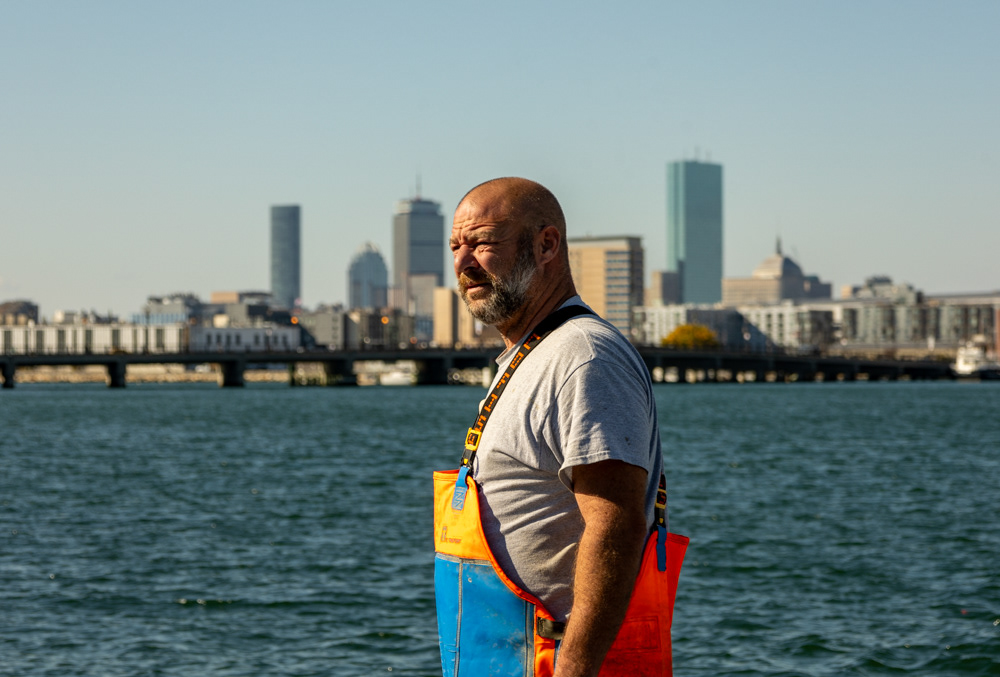
At 5:30 a.m. on Dec. 2, the dock was silent. The seagulls slowly began to wake and the faint sound of water brushing against the dock was the only sound. All the boats were shut off, and not a soul was on the dock. A massive shipping boat from China had just pulled into the MassPort shipping container dock across the channel and loomed above everything nearby. Holler was picking up his breakfast sandwich from down the street, and Lenardis hadn’t answered his phone.
“I’ve always gotta deal with some shit,” Holler growled as he stepped out of his truck onto the cold pavement.
Lenardis had woken up a few hours earlier and shut his alarm clock off by accident, before falling back asleep. Holler texted him repeatedly, finally waking him. They’d get a late start to the morning.
Lenardis arrived at 6:11 a.m., apologetically, and they left the dock about a half-hour later. The plan was to pull 300 traps, and hope to make some last-minute money before pulling the remaining traps out of the water for good over the next few weeks. It’s the worst time of the year, Holler said, because pulling traps out for the season means you’re literally pulling your money out of the water.
“My financial situation right now is catastrophic, to say the least,” Holler said, walking towards his boat, sausage, egg and cheese in hand.
Mediating his uncle’s will while paying off debt and mortgages had continued to prove increasingly costly.
“I’m working much harder than I used to,” he said, and for less money too. He met with his doctor just a few days prior, who told him two new hips and a knee likely lay ahead.
The thought of leaving fishing still remains. He said he could certainly get a job like Lenardis, working maintenance or janitorial at a school, but the work still wouldn’t pay off.
“I wouldn’t be able to make my truck payments,” he said.
Holler signed up for snow plowing in the winter, something he has done for the past few years, but never made it a priority. This winter may be different.
“I hope it snows, a lot,” Holler said.
A portrait of Steve Holler
The price to sell lobsters had gone up to $8 per pound, a helpful increase assuming Holler could catch enough to break even on the roughly $700 it costs to take the boat out each day, after paying Lenardis, fuel and bait. And so they headed out, back to sea again, into the dark December morning fog.
As the skyline of Boston slowly disappeared into the distance, illuminated only by faint moonlight shining through the clouds, Holler stopped the boat for the first time. They took a quick bathroom break off the back of the boat before grabbing their gloves and pulling the first set of traps.
Hours passed and the day looked to be a good one. A set of traps yielded a whopping 43 lobsters late in the day, to which Holler and Lenardis shared a fist bump.
The temperature began to drop as the wind picked up. Holler and Lenardis kept their gloves in front of a heater in between hauls to dry them off and keep them warm. A change of clothes was also necessary because of the cold water drenched on the two men’s sweatshirts. By 2 p.m., the day began to wrap up with 290 total lobsters equalling about 350 pounds. Holler and Lenardis unloaded the tubs of lobsters onto the dock, handing them over to the buyer for $8 per pound. Holler sold the lobsters for about $2,700 that December day, earning himself about $2,000.
Before the season began, in March, Holler walked the cold dock, looking up at November Gale, sitting on stands out of the water. The lobster season was in the depths of its mandatory closure from Feb. 1 to May 1, and Holler was working on boat and trap repairs. His 800 traps sat on the concrete near the trailer that acts as his workshop and office. Sitting in a sun chair surrounded by the traps, Holler said he always seems to scrape by each winter.
When asked if he thinks he’ll make it this year, he said, “Ask me at the end of the year,” with a chuckle.
Now it is the end of the year. Holler is pulling his traps from the water, stacking them in neat rows near his trailer on the dock, where they will sit until May. He’ll make it, he said, he always does. And when May comes and the weather begins to warm, Holler will be out fishing again, for year number forty-eight.
This story was produced for a narrative nonfiction class while Matthew was a student at Boston University. He spent months following Holler, joining him for multiple trips to sea to report on and write this story.